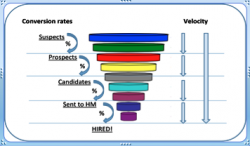Many great recruiting departments and organizations pride themselves on being “metrics-focused” or “metrics-driven” — And for good reason. There’s plenty of research that confirms the value of having clear strategic and operational targets.

In addition, employees appreciate having expectations (think: metrics) that are “SMART” (specific, measurable, actionable, realistic, and time bound). In the recruiting world, some common metrics include time to find, time to hire, survey scores (from hiring managers and candidates), as well as various quality of hire metrics.
How confident are you that you can “hit your numbers”? Are you able to consistently and quickly deliver qualified candidates to your hiring managers? If you are highly confident in your ability to meet or exceed the expectations of your hiring managers, that’s great! Chances are, then, you “know your numbers” very, very well.
This article focuses on one specific aspect of managing opportunities — knowing some key metrics. The next article in this two-part series will focus on some specific techniques for moving individuals through your funnel, or pipeline.
What Have You Done for Me Lately?
In the world of sales, metrics are hugely important. Quota is probably the most famous sales metric of all. I remember vividly receiving my first quota as a new salesperson. I was excited to think that achieving quota meant big commissions. Over time, however, I often dreaded the all-too-frequent “quota conversations” with my sales manager, Stan. Stan could be intimidating. He always wore crisply-starched shirts, preferred suspenders to belts, and loved to smoke cigars — while reminding me that he started his sales career the year I was born. I remember many meetings with Stan where — although his lips were moving — all I heard was Janet Jackson’s voice singing, “What have you done for me lately?”
All joking aside, there are some very good metrics in the sales world that can be useful to recruiters who are looking to increase their ability to meet (or exceed!) expectations. One such set of metrics revolves around activities within the sales funnel, or recruiting “pipeline” itself. Great salespeople know their numbers — and not just their “quota number.” They are excellent at analyzing their ability to achieve “bottom-line results,” based on where opportunities sit in at each stage in their funnel.
Recruiting by the Numbers: Conversion Rates and Time
So the question for you: “How well do you know your numbers?” Great salespeople — and great recruiters — know their conversion rates. At minimum, they know:
- % of suspects they are able to convert to become prospects;
- % of prospects they are able to convert to become candidates;
- % of candidates they are able to convert to being sent to hiring managers;
- % of candidates sent to hiring managers receive offers; and,
- % of candidates who receive offers accept and become employees
Once you know your numbers, you are in a much better position to analyze (and more accurately predict!) your ability to “meet quota.” Knowing your conversion rates helps you build specific, actionable plans that translate to hitting your “hiring quota.” You know how many suspects you need at any given time to produce enough prospects who will, in turn, convert to candidates for your hiring managers.
In addition, recruiters should also have a good idea of the time it takes to convert at each level. So not only should you know your “conversion rates,” but know the speed at which individuals move to each stage in the funnel. This measure is sometimes called “velocity.” Each stage can have both a conversion rate and a time component or metric. The figure at the very top of this post provides a graphic representation of this process.
Forecasting Ability to “Meet Quota”: Making it Real

If you know your conversion rates at key points during the recruiting process, you can use a simple Excel spreadsheet to generate your “dialing plan.” In the table you see here, the person has tracked a conversion rate of 30% for call backs on cold calls — and a conversion rate of 33% for converting those “call backs” into qualified candidates.
Using the example from the table, if you needed to find 10 qualified candidates –and if your only source of suspects to put in your pipeline was through cold calling — you would need to make 100 calls. Of course, the higher the conversion ratio, the more people you are able to “deliver.”
The Change Challenge: Mission Impossible?
“Your “mission, if you decide to accept it … ” is to ask a person who is currently employed — and presumably satisfied with their current position — if they would like to make a change. Why would they? Why should they? As you know, this “mission” presents many challenges. So what’s the best approach to use to help a person decide that change is not only OK, but might even be a good thing!?
In general, moving passive candidates through a pipeline takes some understanding of “change management.” That is to say, if you want to kick up your conversion ratios — as well as your velocity — you not only need to know how many people are at various stages in your pipeline, but you also need to know what decisions they need to make in order to make a change.
Change can be challenging for many people. Change can invoke feelings of fear or loss of control. What can you do to help move them along? What should you not do? How much can you really affect conversion ratios or velocity?
Looking Ahead
In Part 2, we’ll look more closely at the three major decisions that people make as they consider whether or not to advance in each stage of the pipeline. And, more importantly, we’ll also look at the best strategy recruiters should use — at each step along the way — to ensure high conversion rates and optimum velocity throughout the entire recruiting process.